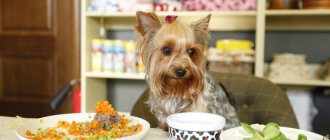The appearance of a baby Yorkie in the house can puzzle an inexperienced owner: puppies of this breed are so small and outwardly helpless that teaching the dog proper eating habits often goes unnoticed. The puppy is pampered, they do not follow the feeding regime, following the lead of pleading eyes, and as a result they end up with a “bouquet” of problems in the form of various pathologies and the pet’s bad character.
In fact, Yorkshire terriers are absolutely self-sufficient dogs, quite self-confident, and do not require a compassionate attitude towards themselves. Due to certain breed characteristics, their feeding must be carried out strictly according to the rules - this will be the key to a limited number of visits to the veterinary clinic (for the purpose of preventive examination and vaccination).
Important points
Yorkies can be called quite demanding guys. This applies to both attention and food preferences.
Be sure to keep in mind that all responsibility for the baby’s health lies with you. Its appearance, condition of teeth and even mood will depend on your correct or incorrect choice.
Yorkies are selective , this is not a dog that you can feed from the table and not think about creating a special menu. This can harm your dog to varying degrees, from digestive problems to death.
Moreover, Yorkshire terriers often refuse to eat on their own and wait until their owners hand feed them. This is an example of improper upbringing , everything is in your hands.
Of course, every dog is different. Even its appearance will depend on the character of your pet. Playful and active Yorkies remain thin, but phlegmatic dogs that do not know moderation in their food run the risk of becoming obese.
The owner’s task is to track all the features of your Yorkie in a timely manner . If he is prone to uncontrolled overeating, limit his portions; if he is inactive, take him for walks regularly and put him on a diet.
What a miracle this York is
The Yorkshire Terrier is a decorative dog whose maximum weight is 3.2-3.4 kg. Most often, representatives of this breed weigh 2.5 kg. Because they are so small, it is difficult to create a diet that fully provides the body with all vitamins and minerals.
A distinctive feature of Yorkies is that all dogs are different in temperament. Breeders will confirm that in the same litter one puppy can gallop like a horse all day long, while the other can sit quietly, looking at the world around him from the box. And it cannot be said that one puppy is good and the other is bad. They are just so different, these Yorkshire terriers.
Due to differences in activity, nutrition for each person must be selected individually. Energetic and nimble, terriers are usually thin and picky eaters. It happens that it is simply impossible to persuade them to eat. Slow dogs love to eat and often gain excess weight. Their diet needs to be controlled and taken out for walks more often.
If you don't train terriers, they become capricious. Yorkie puppies are so cute that at home they are often treated as toys rather than dogs. They are pampered and hand fed. And they really like it and it becomes the norm.
The owner must make it a rule: feeding should be according to a schedule, at the same time, in a specially designated place.
This must be done due to the fact that Yorkshire terriers are easily disrupted by the gastrointestinal tract, which causes a disruption in the body’s functioning.
Newborn care
The Yorkie puppy spends the first days and months with its mother. The life of tiny babies weighing from 80 to 120 grams completely depends on the amount of milk from their mother . The sucking reflex is innate in babies, however, if you notice that your Yorkie cannot cope on its own, gently hold it near the fullest nipple .
In general, problems should not arise during the natural feeding stage. The first two weeks are very revealing, so puppies must be weighed daily . Normal weight gain is considered to be at least 5 grams per day, after a two-week mark - at least 10 grams per day.
If a situation suddenly arises when the bitch cannot feed the puppies on her own, it is necessary to introduce her milk replacer and feed them every 1-2 hours. colostrum for at least a day , otherwise they most likely may not survive.
How can you help your baby? Prepare a milk mixture from cow or goat milk, one yolk, cream, 40% glucose solution and oil solutions of vitamin A and D. Be sure to heat the mixture to 30-35 degrees.
What should a nursing bitch eat?
The health of the puppies directly depends on the mother's nutrition. During lactation, the animal requires a special approach to nutrition. A nursing dog eats up to 4 times more than normal .
Carefully monitor the quality of products. The diet for the first days should include fermented milk products (low-fat), cereals and plenty of water .
Next, the dog should eat as usual: either dry food or natural food. Among dry food, you can choose specialized food for lactating bitches. During feeding, the number of meals increases up to 6 times .
Food for a nursing bitch must meet the following criteria:
- nutritional value;
- the percentage of protein in the composition is from 24 to 28%;
- high content of minerals and vitamins.
Water in your Yorkie's diet
The importance of water in a dog's diet cannot be overestimated. This is the only product on the menu that you can’t have too much of: a dog will never drink more than normal, so a bowl with clean water should always be freely available to the puppy. The water must be changed so as not to cause rejection from the drinking process.
It is extremely important to teach your puppy to drink water from a very early age, especially if the pet is on a commercial diet.
This is important: milk, soups, and any liquid products in the diet cannot replace water for a dog, since they are food!
For a number of reasons, modern Yorkies are rather spoiled creatures, suffering from low immunity and a tendency to allergies to food components. The more owners take an adequate approach to feeding their pets, the faster changes will occur, as a result of which the Yorkshire Terrier will regain its former glory as a long-lived dog.
Feeding the puppies
Starting from the end of the second week, you may think about introducing complementary foods . Add one food item to your diet once a day.
Goat, sheep or cow's milk (warmed), kefir and fresh cottage cheese are perfect for starting complementary feeding . Literally a teaspoon at a time. After making sure that complementary foods are well absorbed and do not cause problems in the dog’s digestion, increase the number of complementary feedings to 2-3 times a day.
Starting from the middle of the 4th week, you can diversify your diet by eating meat . Finely chop the raw meat, add a little warm water and give it to the puppy to try. After a couple of weeks of this diet, you can give boiled meat several times a day.
By the end of the 6th week, the puppy's nutrition will look something like this: 2 milk meals, 2 meat meals and 2 more with mother's milk.
It is important to approach your dog's diet correctly. It directly depends on the age of the puppy .
- From 3 to 6 months – 4 meals a day.
- From 6 to 12 months – write 3 times a day.
- From one year and older – 2 meals a day.
List of prohibited products
It is important to exclude prohibited foods from your Yorkshire Terrier puppy’s diet:
- Bones, pure fat, skin, especially poultry.
- Palm oil.
- Grapes, raisins.
- Soy.
- Mushrooms.
- Corn and semolina.
- Raw freshwater fish and dry, salted fish.
- Products containing sugar or its substitutes, xylitol (chewing gum, some sweets), flour or yeast, caffeine, cocoa, any stimulants (sweets, tea, coffee, chocolate), marinades, salt, spices.
- Smoked products, including sausages, balyki, fish.
- Expired products.
- Leftovers from the table.
Controversial foods in the diet of a Yorkshire Terrier puppy are:
- Lean raw pork.
- Raw ocean fish.
- Whole milk.
- Honey.
- Chicken eggs.
- Raw and boiled chicken liver in large quantities.
Controversial products can and should be given to a Yorkshire Terrier puppy if an allergic or other acute reaction does not occur after taking them.
What is strictly forbidden to feed a Yorkie?
Under no circumstances should you mix dry and natural food . You must choose one path and follow it all the time.
Always remember the list of these products and never let your pet eat them :
- Sweet . No cakes, pastries or sugar. Even if he asks a lot. Never and in any form if you do not want to treat a diseased liver, diabetes or teeth.
- Salt . Do not salt the food. Salt for dogs is pure poison. Spices and other strong-smelling ingredients can deprive your dog of his sense of smell.
- Yeast dough and bread .
- Lamb and pork are too heavy meats for Yorkies.
- Bones . The Yorkie is not a dog that should be allowed to chew on a bone. Unless they are toys from a special store.
- Grapes and raisins harm the kidneys.
- Raw fish is extremely dangerous for a dog's life.
- Onions in any form.
- Any seeds or pits because they may contain cyanide toxin.
- Alcohol.
Treat your dog's nutrition responsibly, feed it high-quality food or food, and avoid eating prohibited foods. Don't feed your Yorkie food that is too hot or cold.
Give your dog 15 minutes to eat, then remove the bowl. Don't worry if he hasn't eaten in these 15 minutes, just offer him again in a few hours.
If you have any doubts, consult with breeders or veterinarians, and then your dog will be well-fed and healthy.
Natural or dry food
There is no single correct answer to this question. The choice is up to the owner. It is important to know that you cannot constantly switch from natural food to dry food and vice versa. You need to give preference to one and constantly follow it.
It is necessary to monitor whether there is an allergy to the finished food. It may not occur immediately, but some time after introducing this food into the diet.
If a Yorkshire Terrier is fed natural food, then sometimes it needs to be given vitamins. It is better to find out which ones are suitable for your pet from a doctor at the veterinary clinic.
There is no need to leave uneaten food in the bowl. It must be put in the refrigerator and given later if it becomes clear that the dog is hungry.
You should not spoil your Yorkie with pieces from the table, and you should not follow his lead if he begs. Proper nutrition is the key to the health of any animal.
When can you feed Yorkie puppies and with what?
Feeding and weaning of puppies
From 3-4 weeks, you can start feeding puppies food in liquid or porridge form. In an earlier period, you can practice supplementing puppies with milk replacers, which is justified for large litters that cannot grow normally without additional complementary foods. The reason for insufficient weight gain may be competition between puppies and pushing aside weaker ones. In this case, underweight puppies must be supplemented.
What to feed puppies? The food they will eat after weaning. If we are talking about ready-made food, then it is better to take specialized food for puppies of this breed group (dry food must be soaked, wet food must be heated in a water bath without overheating). If this is a homemade puppy food, it should be ground after cooking (puree it in a blender). That is, homemade food should be quite liquid - the consistency of a thin puree. Also, many manufacturers have special ready-made mixtures for feeding puppies, usually called “puppy porridge.”
At what age can puppies start feeding complementary foods?
From 3 weeks you can start complementary feeding. The feed mixture should be fresh and heated to body temperature (38-39°C). At first, puppies, as a rule, pay little attention to food, because the main supply of nutrients comes from milk. But when one puppy starts eating food, the rest follow suit.
If puppies ignore the food, you should gently try to attract them to it - by gently bringing your nose closer to the food or by placing a small amount of it in your mouth with your finger. Coercive measures are, of course, strictly excluded.
Feeding complete (commercial) puppy food. When switching puppies from 3-4 weeks to semi-solid food, it is recommended to choose a fairly energy-intensive food (specialized for puppies) and add water to turn it into a thick porridge. Canned (wet) food is diluted with water in a 1:1 ratio; dry food requires adding three times the amount of water. The water for soaking dry food should be at a temperature of approximately 50 degrees, then soaking the food will take 10-15 minutes. If the water is colder, the food will take longer to soak. The food should be at least at room temperature, and preferably at body temperature . If a bag of food is placed on the balcony (or in a cold room) in winter, the food may soak longer, which already violates the conditions for using the food. Warm it up before soaking it.
Food for Yorkshire Terriers
Yorkshire Terriers eat premium food , so you should be prepared to pay a lot of money for it. But they are of high quality and guarantee the health of the digestive system, but you can prepare treats with your own hands.
sold : dry and canned .
It’s up to you to decide what you can feed your Yorkshire Terrier and what kind of food.
We will offer only a few proven brands that have the best food for Yorkies , a special line of food for representatives of this breed:
- Royal Canin. Yorkshire Terrier (there is also specialized food for puppies of this breed);
- Pro Plan - food for small breeds;
- Acana - food for small breeds (the peculiarity is that it does not contain rye, gluten, or corn);
This is only a small part, there is a great variety of food . To avoid running your eyes and asking questions about what is the best food and from which manufacturers for Yorkies, first go to the veterinarian. He will advise you on what you can feed your Yorkie besides dry food, which is suitable for your pet.
Advice! When buying a puppy, ask the breeder what is the best food to feed your Yorkie and how he fed the baby. Moving is already a big stress for the dog, so there is no need to suddenly change the diet.
Webinars for breeders and dog owners
Webinar on feeding a puppy from the first day of life -
How to feed newborn puppies? How to feed? How to wean? Is my puppy growing properly? Supplements – necessary or not? When to switch to adult food? Examples of homemade diets. Is a mixed diet taboo or sometimes okay? Commercial feeds - can they be combined and how correctly?
Webinar 101 questions about feeding dogs and cats -
Answers to the most common and controversial questions about feeding dogs and cats. Everything that is hotly debated: conflicting opinions, myths and facts, truth and fallacy. We collected 101 questions and provided a scientifically proven answer to each.
BARF webinar - all the pros and cons -
You will learn a lot about the properties of the components of BARF diets, the hygienic aspects of such feeding, and general questions and answers that are often heard in the practice of a veterinary nutritionist.
Dietetics course for breeders and dog trainers -
A course of 15 webinars teaches the basics of feeding dogs and cats. You will learn to compare foods and feeding techniques. Learn the principles of diet planning. Study feeding puppies and kittens, adult dogs and cats, during pregnancy and lactation, overweight, and different activity levels.
Basic knowledge
The average fat content of a bitch's milk is 9-10%. The substitutes you choose should have exactly the same fat content or slightly less. Often, owners make a common mistake and start feeding their puppies too early. Often this is not necessary. If the puppies sleep most of the time and gain weight normally, then everything is fine and there is no need to get up at night with the intention of bottle-feeding them. Don't forget that a bitch produces as much milk as her puppies drink. That is, with supplementary feeding you will stimulate a decrease in its amount.
When to offer puppies a saucer
It depends on the specific situation. There are objective reasons why you need to supplement earlier. If the mother's milk supply is low or the litter is very large, goat's milk is the best choice. It is advisable to use raw, whole. You can add one yolk to a glass of milk. Before reaching four weeks of age, it is best to use quail eggs, and then add chicken eggs.
It makes sense to start feeding puppies at 14 days of age if weight gain has slowed down. If they continue to recover well, you can defer the introduction of additional feeds for another week. Or you can wait another week and start weaning on solid food from four weeks of age.
Second month of life
The beginning of complementary feeding for puppies marks a new stage in the lives of babies. Now they are less and less dependent on their mother and spend more and more time exploring the world around them. Starting from week 5, additional foods can be introduced into the diet, one every three days. It is very important to prioritize the range of meats. Veal is a choice for first feeding, but not the only one. The only limitation is fatty pork, as well as pieces of lamb with tail fat. By the way, fatty chicken is also prohibited; you need to choose a young bird or remove excess fat.
At this age, milk ceases to play a primary role in the lives of babies. Now it is gradually being replaced by fermented milk products. It is best to prepare them for puppies yourself. In this case, you can be confident in the quality of the finished product. At the same time, raw calcined foods are better absorbed, so you should give them preference.
The first foods for puppies are an introduction to basic foods. Therefore, take into account the tender stomachs of babies and give them food in small portions. This will avoid stomach problems, bloating and diarrhea. Like a small child, a puppy’s gastrointestinal tract is still imperfect.
Vitamins and minerals
When to start feeding puppies, each owner decides independently, focusing on their charges. If the mother feeds them well, then calmly enjoy a carefree life until they are 3-4 weeks old. But if the bitch does not have milk or, even worse, she gets sick or dies, then you will have to take care of feeding the babies.
From 6 weeks, puppies begin to be offered raw fish. It is a source of phosphorus and calcium. From this time you can begin to introduce vegetables and fruits into your diet. These are apples and carrots, lettuce and cucumbers, zucchini and pumpkins. Fish and meat bones can be fed to the puppy in ground form, mixed with meat. Do not forget that their share should not be more than 15%. You can and should give your kids large beef bones. This is a toy and a treat, and also a necessary thing for scratching growing teeth. But bones should only be given to well-fed puppies at night. At this age they are fed 6 times a day, and by 8 weeks the number of feedings is reduced to 3-4 times a day.
from 21 days to 2 months
PORRIDGE FOR A BABY.
A small puppy aged about a month (from 22-23 days) begins to be introduced to complementary foods so that he can adapt to life in the big world. Ideally, the puppy's mother regurgitates the half-digested food and the mother's enzymes pass to the puppy. Such babies, having left the parental nest, have a more stable immunity to various intestinal disorders. But it also happens differently. Puppies have to explore the new world of food on their own.
Some breeders introduce cow's milk and semolina porridge, baby food from jars as complementary foods, considering this method the best. We are against it! This is not suitable food for dogs. Firstly, semolina porridge is good for very exhausted organisms. Why do we need fat Yorkies? And the benefits of such porridge are questionable.
Semolina binds calcium and increases bone fragility (osteoporosis), reduces the absorption of iron (rickets, anemia).
Semolina has little protein and virtually no vitamins, but a lot of carbohydrates.
Semolina is well absorbed in the gastrointestinal tract, so it is recommended for elderly and emaciated dogs, but in no case for puppies. A dog is a predator, albeit a small one.
The best food for a predator is meat and dairy products.
The ideal complementary foods for puppies are the following products: – frozen beef, scraped, – kefir 3.2% fat, – cottage cheese 2-5% (natural) liquid Vitamins and mineral supplements are best given not to puppies, but to the nursing mother during the entire pregnancy and period feeding puppies. If it is not possible to feed the puppies natural food, then give high-quality industrial food soaked in kefir or warm water (FOR PUPPIES!) The food manufacturer can be any, the main thing is that the granules are very small. Look at the packaging for the date of manufacture. DO NOT BUY loose food! Only in sealed packages can food be stored without oxidation.
So, for the first time we let the puppies try food (meat, industrial food) from our hands.
Once a day is enough. The next day, double the portion. Then at three. Gradually add up to half a teaspoon and offer to eat from a small saucer.
You can pour milk into a saucer (1 cup boiled milk + 1 raw quail egg + 2 drops of honey) and offer it to the puppies. If there is not enough mother’s milk (for example, there are a lot of puppies), then the babies will happily try to lap. Learn quickly!
By two months, our puppies are already eating all fermented milk products, raw meat (beef), meat soufflé, boiled beef and turkey, and soaked high-quality food on their own.
Fresh fruits and vegetables should NOT be given at the age of 21 days to 2.5 months; you must wait until microflora is formed in the intestines that can break down fiber, and this will not happen earlier than 3 months. We recommend not giving milk after two months, although some owners do not agree with such advice.
If the owner himself likes to drink a glass of milk at night, then his pet also gets used to this ritual: 25-30 grams (a tablespoon) of milk at night guarantees sound sleep and no disturbances!
Based on the book by I. Manina “Yorkshire Terrier. Nutrition and health."
"Moscow Talisman" Kennel of Yorkshire Terriers. Copyright © 2001 - 2022. All rights reserved.
Source
From 8 weeks
By this time, the digestive system has time not only to form, but also to get stronger. Puppies can start giving offal. But you also need to choose them carefully. For example, the puppy will swallow chicken necks, but will gnaw on the backs. Tripe can also be given in the proportions recommended for adult animals. The frequency of feedings is now gradually decreasing, but the portion is increasing.
A baby at this age eats as much as an adult dog of the same breed, if you take the daily amount of food. Males always eat more than females. For normal digestion, you must add chopped fresh herbs. By this age, the number of feedings per day is reduced to three, but the diet should still include fermented milk products.
Feeding Yorkshire puppies
Depending on the breed, the rules for introducing complementary foods may vary. This is especially true for miniature animals that are bred artificially. Tiny Yorkies quite often experience digestive problems. The stomach is often simply not able to digest the volume of food that the body needs due to its size. Therefore, special feeds are used for them, which, in a small volume, provide a good supply of nutrients.
Therefore, complementary feeding of a Yorkie puppy is most often carried out using soaked dry food “Starter Pappy”. Mash it with a fork until it becomes a paste. And when the kids grow up a little, they simply eat it soaked and wash it down with water. From two months you can switch to Mini Junior. Most breeders agree that this is the best feeding for Yorkies.
Choosing a place and dishes
This issue should be resolved before the puppy arrives in the house, and it is correct if the chosen place for feeding does not change in the future. Since these small dogs do not require large areas for their “table,” bowls can also be placed in the kitchen. For food and water you need separate dishes that need to be washed regularly.
It is better to choose dishes made of stainless steel - this is the optimal price-quality ratio, but you can also buy plastic and ceramic ones. The bowl is selected so that a single portion of food occupies approximately 2/3 of its volume. Since puppies turn over plates when feeding, it is worth purchasing a special mat on which the bowl will not “slip.”
Special devices are very convenient for feeding - rods, table tops with holes. All these attributes are sold in pet stores, and a consultant will help you decide.
The so-called ball drinker, otherwise called “dry whiskers,” has become very popular, designed specifically for bearded and mustachioed dogs. With such a device, you can safely leave your dog for the whole day without worrying that he won’t have enough water.
Large breed dogs
The most popular can be considered the German Shepherd. Complementary feeding of shepherd puppies begins from 18-20 days of life. These puppies are quite large and require a lot of calcium and nutrients to grow and develop. From this time on, calcined cottage cheese can be introduced. It performed very well in the combination “cottage cheese - milk - raw egg” or “cottage cheese - egg - carrot juice”. From day 22 you can add lean beef. To do this, it is scraped or ground in a blender. A good option would be a mixture of milk, cottage cheese and minced meat.
From about 26 days of life, milk porridge can be introduced into the diet. Cereals must be ground in a coffee grinder. Start with one cereal, and when your baby’s stomach gets used to it, you can add the next one.
How much food does a puppy need?
For medium and large breed puppies, there is a clear formula: they need 5 to 8% of their body weight. Moreover, this portion is adjusted once a week. But the main guideline remains the condition of the puppy. He shouldn't get fat or look thin. You can focus on the ribs. They should not bulge, but upon palpation they can be easily felt. If the puppy is cheerful, runs around a lot and is interested in the world around him, he will definitely have a good appetite. At the same time, it is necessary to provide him with high-quality food, complete sources of all necessary nutrients.
Sources:
https://mirsobak.net/porody/karlikovye/jorkshirskij-terjer/kormlenie-jorkov.html https://vetdietolog.ru/maindocs/prikorm-i-otyem-shchenkov https://fb.ru/article/415496/ prikorm-schenkov-kogda-vvodit-s-chego-nachinat-i-skolko-davat-edyi-v-den











